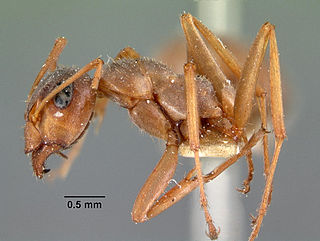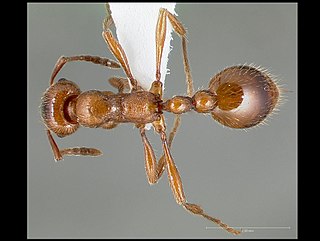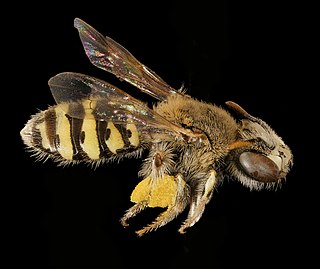Nomada verecunda is a species in the family Apidae, in the order Hymenoptera . Nomada verecunda is found in North America.
Centris cockerelli is a species in the family Apidae, in the order Hymenoptera . The distribution range of Centris cockerelli includes Central America and North America.

Hoplitis anthocopoides is a species in the family Megachilidae, in the order Hymenoptera . The distribution range of Hoplitis anthocopoides includes Africa, Europe, Northern Asia, and North America.

Formica montana is an ant in the genus Formica in the family Formicidae. A common name for F. montana is "prairie mound ant".

Andrena crataegi, the hawthorn miner bee, is a species of miner bee in the family Andrenidae which is in the order Hymenoptera. Another common name for this species is hawthorn andrena. It is found in North America.

Colletes simulans is a species in the family Colletidae, in the order Hymenoptera. The species is known generally as the spine-shouldered cellophane bee. It is found in North America.
Stictiella formosa is a species in the order Hymenoptera, in the class Insecta ("insects"). The distribution range of Stictiella formosa includes Central America and North America.

Formica fossaceps is a species of ant in the genus Formica, in the family Formicidae. This species is a member of the Formica rufa species group.
Andrena palpalis is a species of mining bees in the family Andrenidae. It is found in Central America and North America.
Triepeolus grandis is a species of cuckoo bees in the family Apidae. It is found in the United States and Mexico.

Manica hunteri is a species of ant in the family Formicidae.

Triepeolus is a genus of cuckoo bees in the family Apidae. There are at least 140 described species in Triepeolus. The majority of species whose life history is known are kleptoparasitic in the nests of bees in the tribe Eucerini, especially the genera Melissodes and Svastra.
Stictiellina is a subtribe of wasps in the family Crabronidae. There are at least 60 described species in Stictiellina.

Calliopsini is a tribe of mining bees in the family Andrenidae. There are at least 120 described species in Calliopsini.

Ectemnius cephalotes is a species of square-headed wasps in the family Crabronidae. It is found in Europe and Northern Asia as well as North America.

Bombus vandykei, the Van Dyke's bumble bee, is a species of bumble bees in the family Apidae. It is found in North America.
Psen monticola is a species of aphid wasp in the family Crabronidae. It is found in North America.
Triepeolus rufithorax is a species of cuckoo bee in the family Apidae. It is found in North America.
Isodontia exornata is a species of thread-waisted wasp in the family Sphecidae.

The cherry leaf miner bee is a species of miner bee in the family Andrenidae. Another common name for this species is cherry plum miner. It is found in Central America and North America.











